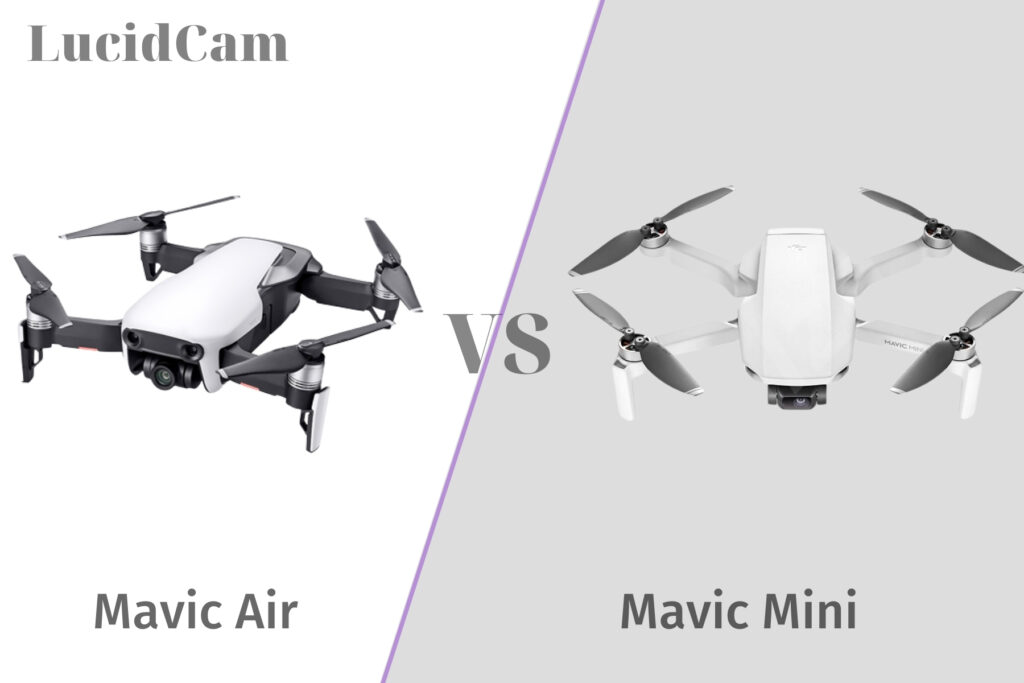The DJI Mavic Mini and the DJI Mavic Air are two of the most popular drones on the market. They both have a lot of features that help them stand out from other models, so it can be hard to decide which one is best for you.
In this blog post, LucidCam will talk about what sets these two models apart and how they compare with each other in terms of their specs.
Table of Contents
- 1 Mavic Mini vs Mavic Air
- 1.1 General Information
- 1.2 Pros And Cons
- 1.3 Mavic Mini vs Mavic Air- Design
- 1.4 Mavic Mini vs Mavic Air- Gimbal & Camera Performance
- 1.5 Mavic Mini vs Mavic Air- Flight Performance
- 1.6 Obstacle Avoidance Systems
- 1.7 Intelligent Flight Modes
- 1.8 Mavic Mini vs Mavic Air- Battery life.
- 1.9 Mavic Mini vs Mavic Air- Remote Control.
- 1.10 How Do They Fly?
- 1.11 App
- 1.12 Pricing
- 1.13 Which Drone Is Best For You?
- 2 Conclusion
Mavic Mini vs Mavic Air
DJi recently introduced the Mavic Mini, its newest consumer drone. DJI’s smallest drone, the Mavic Mini, weighs in at 249g. This allows users to fly it in almost all countries without worrying about restrictions. With the DJI Mavic Mini now available, drone pilots can choose from the DJI Mavic Air or Mavic 2 series.
But which Mavic is right for them? We have listed their differences below to help you choose the perfect Mavic companion.
General Information
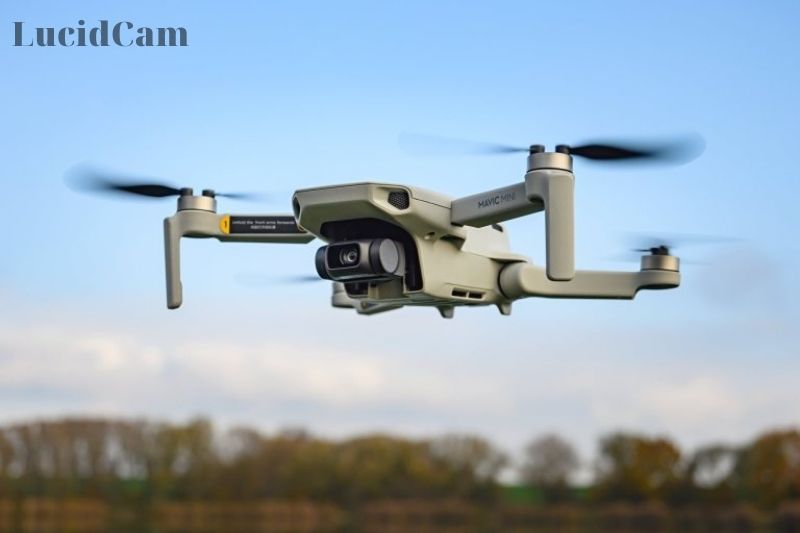
DJI Mavic Air
- DJI’s midsize Mavic Air can shoot 4K video at a cost of $919
- Although you can fly the Air using the DJI app on your tablet or smartphone, you will get greater range and speed if the controller is used.
- Air uses the smartphone as a controller, and the range with the controller can be up to 2.4 miles.
- Your smartphone is used by the controller to display what the drone’s camera sees as you fly.
- The Air can travel at a maximum speed of 42.5 miles an hour. It also has forward and reverses obstacle avoidance to keep you from getting into anything.
- It can be folded up for easy transport s is the case for all Mavic Series drones. The drone’s dimensions when extended for flight are 6.61×7.24×2.51 inches. When folded, it measures 6.61×3.26×1.92 inches.
- It is less than one pound (1.16 ounces) in weight and can fly for 21 minutes.
- Video Resolution: 4K Ultra HD: 3840×2160 24/25/30p 2.7K: 2720×1530 24/25/30/48/50/60p
DJI Mavic Mini
- DJI released the Mavic Mini ($399) in October 2019.
- The Mini is very light at 8.78 ounces or 249g, which is significant.
- The FAA must register drones weighing more than 250 grams. If you are flying recreationally, drones less than 250g don’t need to be registered. However, you must still follow the drone laws.
- The Mini measures 6.29×7.95×2.16 inches when folded. The Mini folds down to 5.51×3.22×2.24 inches. This is small enough for you to hold in your palm.
- The Mini isn’t as feature-rich as the Air, as you might imagine.
- It is impossible to shave $500 off the price without excluding some items.
- Mini’s camera can record 2.7K videos, whereas the Air can only record 4K. Both drones produce amazing videos.
- The DJI Fly app features many templates so users can generate awesome videos with just a few taps. This app is perfect for users with no editing experience, offering creative options to turn any video into a share-worthy clip.
- Video Resolution: 2.7 K: 2720×1530 25/30 p
DJI Mavic Mini doesn’t have forward or backward obstacle avoidance. The Mini does have downward obstacle detection, which will alert you if it senses that its landing area is unsafe. It also stabilizes hovering by using downward sensing.
You cannot control the Mini from your smartphone. The Mini’s controller must be connected to your smartphone or tablet.
The range of the Mavic Mini is up to 2.4 miles unobstructed. The controller was having trouble connecting to the drone when it was within a city with many buildings and trees. Flying above White Rock Lake gave me a greater range and I was able to fly further than two miles.
The Mavic drones are equipped with GPS and a Return to Home feature. This will allow you to bring your drone back home by pressing one button.
If the drones fly too far, lose connection for more than 20 seconds, or the battery gets very low, the Mavic drones will return home.
Mini’s camera is mounted on a 3-axis mechanical gimbal. This ensures that the video is stable. Amazing to see the drone being buffeted by wind, yet still providing video that looks like it was taken with a tripod.
There are three modes of flying on the Mini: Speed (the fastest mode), Place (standard mode), and Cinematic (a slow, deliberate maneuvering mode that is ideal for smooth video productions).
Pros And Cons
Mavic Mini
PROS
- Entry cost is low
- The remote controller is available.
- Impressive battery life.
- Crisp 2.7K video and 12 MP photographs
- Gimbal stabilization.
- Automated camera movements for cinematic purposes
- Use the Find My Drone feature.
- Doesn’t require federal registration.
- Easy to use drone
CONS
- Testing may have some connectivity problems
- Omits obstacle detection sensors.
- No 24fps video option.
- Does not support HDR or Raw images
Mavic Air
PROS
- Very little.
- Video with high bit rate 4K UHD.
- HDR and Panorama still capture.
- Raw and JPG support.
- Asteroid video shot.
- It is possible to avoid obstacles.
- Intelligent flight modes
- 12 MP photo
CONS
- USB charging is not supported.
- No 4K DCI video.
- Panorama stitching requires some effort.
- The real-world flight takes around 18 minutes.
Mavic Mini vs Mavic Air- Design

DJI’s Mavic Mini is the lightest, at 249g. The Mavic Mini folds down to 140x82x57mm (LxWxH), and when folded it unfolds to 160x202x55mm (LxWxH). The Mavic Mini folds up easily and can be carried in your palm. The Mavic Mini is a miniature version of the Mavic 2 but has a matte, light-grey color. Mavic Mini is in the lowest weight class of drones.
The Mavic Mini’s main draw is its lightweight. It falls under the most common weight category for drones in most countries. DJI is proud of this achievement as drone enthusiasts are able to fly the Mavic Mini with no restrictions or regulations.
It is also a foldable design and can be folded down to the same size as a smartphone. Size-wise, the drone weighs in at 430 grams. It is between the Mavic Mini 2 and Mavic 2. The drone has an industrial design and is available in three colors: black, white, or red. A foldable, small leg extension that can be folded up will lift the drone’s front approximately one inch above the ground.
Mavic Mini vs Mavic Air- Gimbal & Camera Performance
The DJI Mavic Mini is small, but it has a powerful camera that can capture stunning aerial shots. The Mavic Mini can capture 2.7k video at 30 frames per second and 12-megapixel stills using a 1/2.3 sensor. The Mavic Mini does not have 4k capabilities, but the camera is excellent for everyday use. It also has a 3-axis gimbal that produces smooth, stable footage. For professionals, the DJI Mavic Mini cannot shoot in MP4 and JPEG files.
DJI Mavic Air has a 3-axis stabilized gimbal system that allows for smooth, shake-free footage. It can also shoot 4k videos at 30 frames per second. A 1/2.3 CMOS sensor can also be used to capture 12-megapixel stills. It has more options for formatting and can be used to shoot in JPEG and DNG RAW formats. The Mavic Air’s powerful camera can be used by both semi-professional and recreational users.
These camera drones all have different uses, depending on what you use your camera for to choose the type of drone that’s right for you.
If you want to a nice picture or record a great video you can get Mavic 2 Zoom with camera quality. It can record 4K video at 30 frames per second and stills at 12 MP. The drone’s zoom capabilities allow it to capture unique shooting modes such as Super Resolution. This allows the drone to create stunning 48-megapixel photos. Dolly Zoom The cinematic effect of zooming in on a subject distorts its background.
Mavic Mini vs Mavic Air- Flight Performance
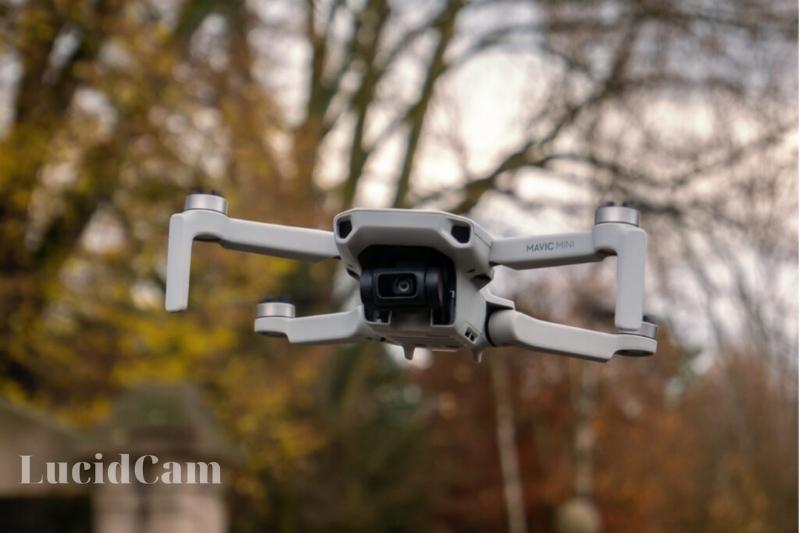
Mavic Mini
- Max Flight Time: 30 minutes flying at 14 km/h in windless conditions
- Maximum Wind Speed Resistance: 28.8 km/h
- Max Speed (near sea level, no wind):
- 13 m/s (S-Mode)
- Distance: Maximum 4 km
- Video Transmission System: Enhanced Wi-Fi
- Operating Temperatures: 0°C to 40°C
-
Three Vision Sensors: Mavic Air offers a safe, reliable flight performance with forwarding, backward, and downward dual-vision sensors.
- Obstacle sensors are great feature
Mavic Air
- Max Flight Time: 21 minutes (at a consistent 25 kph)
- Maximum Wind Speed Resistance: 29-38 kph
- Max Speed (near sea level, no wind):
- 68.4 km/h (S-mode[1]).
- Distance: Maximum 4 km
- Video Transmission System: Enhanced Wi-Fi
- Operating Temperatures: 0°C to 40°C
Although the DJI Mini is small and light, it is powerful and delivers great flight performance. Due to its lightweight design, you can enjoy up to 30 minutes of flight time with Mavic Mini. and a maximum range of up to 4km. To maintain strong connections and minimize interference, the drone uses an enhanced Wifi system. It bounces between 2.4Ghz & 5.8 GHz. The drone is lightweight and small enough to be carried in your pocket. It can still handle wind speeds of 28.4 km/h under warranty, which is another great achievement for DJI. It is extremely stable and precise in flight, making it easy for novice pilots to fly.
The mini has three flying modes: Speed (the fastest mode), Place (the standard mode), and Cinematic (a slow, deliberate maneuvering mode that is great for smooth video productions).
The Mavic Air has the same range as its Mini counterpart, but with a shorter flight time and a range of 4 km and 20 minutes respectively, the Mavic Air is more efficient. To maintain strong connections, the Mavic Air uses a WiFi transmission system that can bounce between 2.4Ghz & 5.8Ghz. The Mavic Air is slightly larger than the Mavic Mini and can withstand wind speeds between 29 and 38 kph.
Mavic Air, a lightweight and portable drone, offers excellent flight performance both for novice and advanced users. This drone is ideal for travelers and offers high-end flight performance that opens up endless possibilities.
Explore more best places where drones can fly:
Obstacle Avoidance Systems
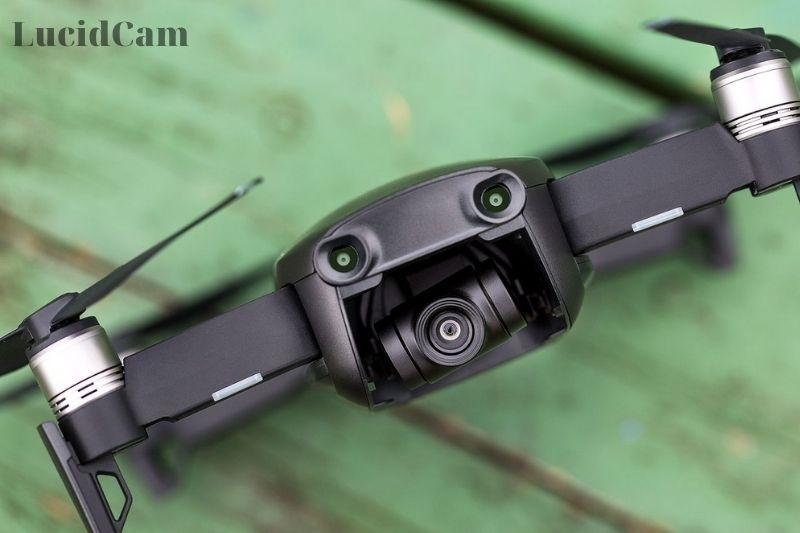
- Mavic Mini: No Obstacle Avoidance Systems
- Mavic Air: Front, Bottom, and Rear Obstacle Avoidance Sensing
Mavic Mini’s obstacle sensors system is one thing it lacks compared to Mavic Air. Only the Mavic Mini has an internal GPS that keeps it in the air and downward-facing vision sensors. The drone’s accuracy and precision in the air make it very easy to fly, even though it does not feature an obstacle avoidance system. Pilots who fly safely and without incident should be able to enjoy safe flights. You can attach propeller guards (to the Mavic Mini) to increase safety. However, this will increase the drone’s weight by 249g. Pilots will need a license when flying with propeller guards.
A good deal of the weight is in the battery, so DJI is able to sell a 199g version in Japan, where drone regulations are more stringent than here in the US.
Mavic Air has an obstacles avoidance system with front, bottom, and rear-facing sensors. Mavic Air’s intelligent obstacles avoidance system makes it easier to avoid obstacles and detect them more quickly.
The Mavic Air’s Advanced Pilot Assistance System will scan the environment for obstacles. It will detect any obstacles and automatically determine the best path to avoid them. If it can’t find one, it will stop and hover in the place it is.
Intelligent Flight Modes
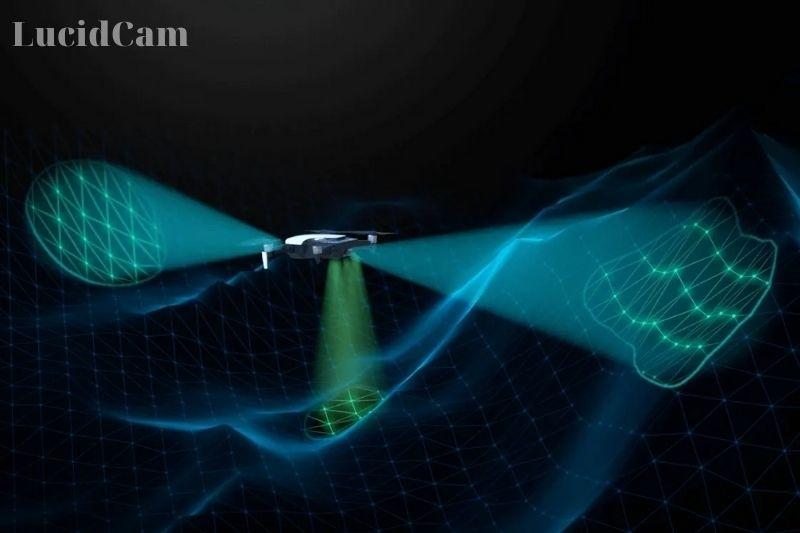
The Mavic Air and Mavic Mini feature the most intelligent flight modes out of all the Mavic drones include:
- Mavic mini: Return-to-Home, CineMode, QuickShot Modes: Dronie, Circle, Helix, Rocket
- Mavic Air: ActiveTrack and SmartCapture, TapFly. Tripod Mode, Cinematic Mode. Point of Interest. QuickShot Modes. Circle, Helix. Dronie. Rocket. Asteroid. Boomerang
The Mavic Mini has the smallest number of intelligent flight modes of any Mavic. The Mavic Mini features Return-To–Home, CineSmooth mode, and four QuickShots options including Dronie (Circle), Helix (and Rocket). QuickShots allows users to quickly capture dynamic and stunning footage. CineSmooth Mode allows for smoother movement and speed of the Mavic Mini. One noteworthy flight mode the Mavic Mini is missing is ActiveTrack, one of the most popular intelligent flight modes featured on DJI drones
The drone can return to the exact spot it was launched from by simply pressing a button, or when it senses that it has a low battery or weak signal. ActiveTrack is a popular flight mode on DJI drones that the Mavic Mini does not have. In future updates, this mode and some of DJI’s most popular modes such as TapFly may be added to the Mavic Mini.
The Mavic Air includes all of DJI’s most popular flight modes, including TapFly, Cinematic Mode, TapFly, Point of Interest, ActiveTrack, and Cinematic Mode. There are also QuickShot Modes such as Dronie, Circle and Rocket, Helix, and Boomerang. The Mavic Air offers a wide range of intelligent modes that will allow users to create cinematic shots and take them to the next level.
Mavic Mini vs Mavic Air- Battery life.
The batteries of the Mini are 2,400mAh. Max flight time up to30 minutes of flight time, depending on your environment. This was about right, although flying in Sports mode can cut a few minutes of the flight time.
On the other hand, The Mavic Air is a foldable design that carries a battery that can last up to 21 minutes of flight time.
Mavic Mini vs Mavic Air- Remote Control.
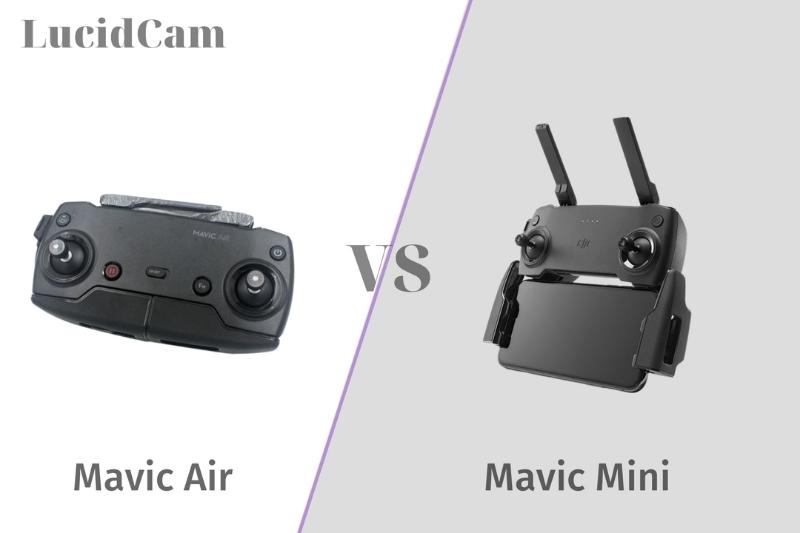
Mavic Air
With the controller, the Mavic Air’s transmission range is restricted to only four km/2.5 miles. This is twice the range of the Spark at two km/1.25 mi, but noticeably less than the Pro’s seven km/4.3 miles. Some people were concerned that the drone’s connection might be affected by this announcement. In our testing of three drones across three continents, we didn’t notice any dropouts. However, if the Mavic Air is being pushed to its limits, there may be some drops in the video feed.
The Mavic Air has 3 axis Gimbal like the Pro. However, it is a redesigned one, which makes the drone more stable. While panning sideways with the gimbal is easy, it can be a little jerky to move the camera up or down. You can keep your footage smooth by switching to Cinematic Mode in the app. This mode slows down the drone and reduces braking to make video smoother. However, even this requires a lot of practice to get a steady capture.
You can also track up to 16 subjects simultaneously. Our DJI Mavic Air review unit could track six subjects individually within ActiveTrack. You can either use them all or one of them as your focal point to switch to QuickShot mode.
SmartCapture is great, but there are additional QuickShot systems called Asteroid or Boomerang that make it even more enjoyable. Asteroid, Boomerang, and Spark have older QuickShot options. They take short videos with a subject in the center. The app is very easy to use, with only a few taps. The first uses multiple shots, which are then combined in-camera into a 10-second blip that begins with the subject and ends in a spherical, bird’s eye view of the location. Boomerang is a drone that pans around the subject and then returns to its original position after completing a 360-degree circuit.
Mavic Mini
The DJI Mavic Mini’s controller doesn’t have a screen, unlike other models. Instead, it opens to hold an Android and iOS smartphone. The joysticks are secured in the body with screws so that it collapses flat and opens out to give it a traditional feel.
The micro USB port on the left side charges your phone and connects it to the controller. You can also get the drone with Lightning, micro USB, and USB-C cables. This means that any smartphone provided compatible with the DJI Mavic Mini Fly app will be supported.
The camera’s jog dial at the top turns the controller vertically through 90° so that it can view forward to the bottom. It can’t look upwards like the Parrot Anafi. However, its range is standard for most drones. The L trigger starts video recording, and the R trigger takes a picture – great if you are operating the drone with gloves.
It is not easy to set up the flying experience. You have to connect the remote control to your smartphone, attach the joysticks, and fire up the app. This takes around a minute. The experience is compact and portable, but the controller and drone can be collapsed. However, it feels solid and natural when flying.
We were able to pair the drone with all our smartphones after it was connected. We tried it with Android 9-10 phones as well as an iPhone.
- Check out How To Connect Drone To Phone 2023: Top Full Guide or How To Connect Drone To Controller 2023: Top Full Guide to know more information
How Do They Fly?
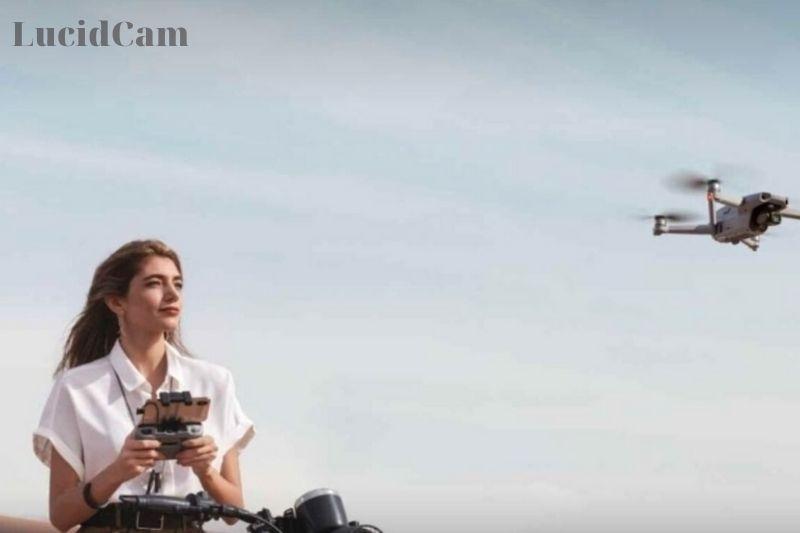
Connect your phone to the controller and power it on. When you see “OK for takeoff” appear on the screen, press the one button to send the drone hovering a few feet above the ground.
These drones are equipped with sophisticated electronics (downward vision sensing), which allows them to hover very easily, especially when you release the control sticks. If you’re learning how to fly and are heading towards a crash, you can release the controls to stop the drone from moving until you are ready.
DJI’s app makes landing and taking off easy. There are two control buttons. The left stick controls altitude, and direction (up/down, and rotate left/right). The right stick controls movement (forward/backward, left/right).
Flying drones are a great option for people who grew up playing video games. You can also see your speed and altitude. A countdown timer shows how much flight time is left on your battery.
Pop-up messages will also be displayed when your GPS is experiencing interference, or high winds could affect your flying.
Quick Shots are a great option for videographers, as they allow you to automate complex video shoots. The circle is my favorite. There are many other video modes, too numerous to list here. Circle allows you to pick a subject and the drone will circle it, keeping it centered, as it circles a large circle. It’s amazing.
App
The DJI fly app has many templates that allow users to create amazing videos in just a few clicks. DJI fly app is great for those with little editing experience. It offers creative options that can turn any video into a shareable clip ( for Mavic Mini)
- Read Best Drone App to learn more
Pricing
Mavic Air is $919 and includes one battery, controller, and carrying case.
DJI also offers the “Fly More” package, which adds two additional batteries, a charging hub, and a travel bag to your drone for $1,149.
Fly More Kit for Mini: This kit costs $100 more and includes two additional batteries, extra propellers with screw heads, a hub for charging the battery, propeller guards, and a travel bag.
Buy the Fly More Kit to save money on drones. It is worth it to get extra batteries.
The Mavic drones fly beautifully and are some of the most enjoyable things I have ever done. On rainy weekends, I would wake up and regret not being able to fly. My wife was annoyed that I took it on walks and picnics, but eventually, she asked me to fly it.
For someone who is interested in learning to fly, the Mini is the right first drone.
It is easy to see why drones such as the Mavic Air are so expensive. These drones can do serious work. High-quality video can be used in TV and movie productions. They could also be used to help law enforcement locate missing people.
Pros: It is unbelievably simple to fly. Amazing range. No FAA registration. Gimbal for steady-video.
Cons: It can be a little pricey.
Which Drone Is Best For You?
The Mavic Mini is a great choice for casual flyers and first-timers who want a simple, safe drone that they can use without worrying about regulations. The drone’s long-range and excellent battery life make it an exceptional drone. It is also the lightest drone in its class. The drone does not have the capability to shoot in 4k, but its 2.7k 12-megapixel camera will provide stunning aerial stills and smooth footage.
The Mavic Mini is an excellent choice for recreational and entry-level users. It also comes with no restrictions on flying, so it’s easy to get around without worrying about government regulations.
The Mavic Air, on the other hand, is the perfect drone for beginners, professionals, or travel enthusiasts who are looking for a budget-friendly drone with a great balance of size, price, and performance. The Mavic Air is an excellent choice for users looking to enjoy 4K video and intelligent flight modes.
Conclusion
Mavic Air is the ideal drone for new users, travel enthusiasts, or professionals who want a more budget-friendly drone that is a perfect balance of price, size, and performance. It is the smaller, more compact version of the world’s most popular drone. It has a new camera that shoots 4K footage at 60 frames per second and can fly for up to 21 minutes on one charge.
The Mavic mini is also an excellent option if you are looking for something less expensive or want to get started with drones without making a big investment in time and money.
We hope this article helped you make your decision about which best drone will best suit your needs!
Read More:
- DJI Mavic 2 Pro Vs Zoom: Which Is Better For You.
- DJI Mini 2 Vs Mavic Air 2: Which Is The Best For You?
- DJI Spark vs DJI Mavic Mini: Which It Better For You 2023
